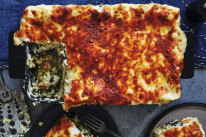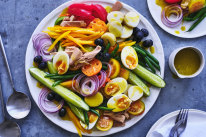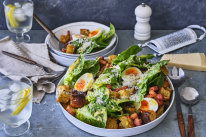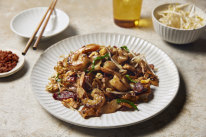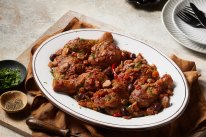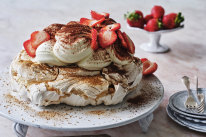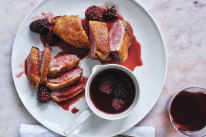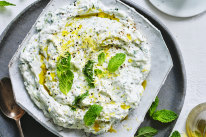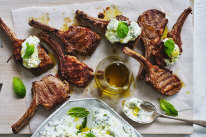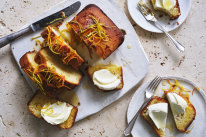Adam Liaw shares the secrets to fail-safe fishcakes (and yes, tinned is totally fine)
A British classic, fishcakes are simple, tasty and easy on the wallet, whether you use fresh fillets, leftovers, or a tin of fish from the cupboard.
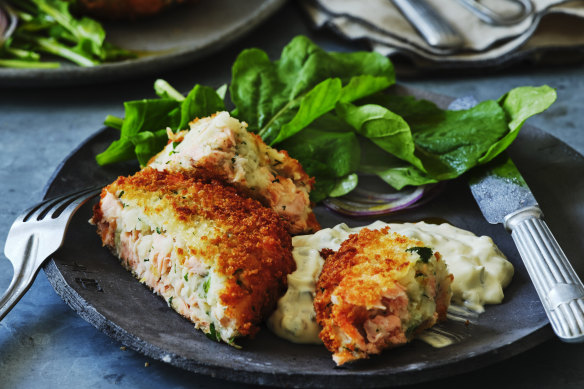
Fishcakes are a British classic and can be made very affordably. Think of them as potato cakes flavoured with as much fish as you might like to use.
Ingredients
500g potatoes, peeled and cut into chunks
20g butter, plus 20g more for frying
salt and pepper, to season
juice of ½ lemon
350g skinless fish fillets such as salmon, ling or barramundi
grated zest of ½ lemon
1 tbsp Dijon mustard
1 tbsp Japanese-style mayonnaise
2 spring onions, finely sliced
1 tbsp finely shredded parsley
1 tbsp finely shredded dill
4 tbsp plain flour
2 eggs, beaten
1 cup panko breadcrumbs
¼ cup vegetable oil, for frying
rocket leaves, to serve
½ red onion, thinly sliced into rings, to serve
Quick tartare sauce
1 cup Japanese-style mayonnaise
juice of ½ lemon
1 tsp Dijon mustard
¼ cup finely shredded dill
¼ cup finely shredded parsley
3 cornichons, finely chopped
1 tbsp capers, finely chopped
Method
Step 1
Place the potatoes into a large saucepan of cold water and bring to a simmer. Simmer for 20 minutes until a small, sharp knife inserted into a piece of potato enters and exits easily. Drain and return to the pot to steam dry. Coarsely mash with the butter and season well with the salt, pepper and lemon juice. Allow to cool.
Step 2
Heat the oven to 180C fan-forced (200C conventional). Place the fish on a piece of baking paper on a baking tray and bake for about 10 minutes or until just cooked. Precisely how long this takes will depend on the size and shape of your fillets, but to test your fish, check the tips below. Allow to cool.
Step 3
Combine the mashed potato with the lemon zest, mustard, mayonnaise, spring onions and herbs. Flake the fish into the mixture in large chunks and mix to combine. Don’t break up the fish too much. Divide the mixture into 4 even parts and form into patties, placing the patties into a plate or tray lined with baking paper. Refrigerate for about 30 minutes until firm enough to handle.
Step 4
With a pastry brush, dust each patty with flour (dusting rather than dipping helps prevent over-flouring), then dip each patty first into the beaten egg, then into the panko, pressing the crumbs onto the fishcakes. Don’t worry too much about the sides. Heat a frying pan over medium heat, then add the oil and butter. Fry each patty for about 3–4 minutes on each side until golden brown, then remove to a plate lined with paper towels to drain.
Step 5
For the quick tartare sauce, combine the ingredients in a small bowl.
Step 6
Serve the fishcakes with rocket leaves, red onion slices, and a big spoonful of the tartare sauce.
Masterclass
Which fish should I use?
The classic British fishcake is made with cod or haddock, but the beauty of this dish is that you don’t have to be particularly fussy about the fish that you choose. A nice piece of Ora King salmon or ling would be great, but they can be expensive. Barramundi is a great sustainable choice in Australia.
Choose a fish that matches your taste and your budget. I’ve specified 350g in this recipe, but you could easily use less. And while I prefer to make fishcakes from fresh fish, tinned fish is completely fine if that’s what suits you.
How to check whether the fish is cooked
If there’s one thing that gets my goat in cooking, it’s the bureaucratic “recommended” internal temperatures for cooking meat, fish and poultry. If we followed those guidelines, every steak you ate would be past medium-well, every chicken as dry as a bone, every piece of fish rubbery and tasteless, and sushi and sashimi wouldn’t exist.
If you’ve eaten something at a restaurant that was cooked to the internal temperature recommended by food authorities, it probably wasn’t a very good restaurant, and you probably didn’t have a very nice meal.
The recommended internal cooking temperature for fish is 63C, which is 15C above what I would cook most fish. I prefer fish at an internal temperature of around 48-50C, where it’s still moist but pleasantly flaky.
While I prefer to make fishcakes from fresh fish, tinned fish is completely fine if that’s what suits you.
If you have a probe thermometer, you can use that to check the temperature, but most chefs will just use a metal skewer. Insert it into the thickest part of the fish, leave it there for a moment, then withdraw it and hold it against your lip. If it feels warm, it means the fish is past your body temperature of 38C, and so it should be ready.
Which breadcrumbs should I use?
Even though I’ve suggested panko crumbs, don’t feel wedded to that. Panko are coarse and fluffy Japanese breadcrumbs made from bread that is risen using an electric current rather than baked, so the crumbs are still pale but light. When I was growing up, there was always a tray of bread crusts in the oven drying to make homemade breadcrumbs, and I’m not sure that still happens in many households.
Food waste is an enormous issue, and we need to do what we can in our kitchens to reduce it.
Fishcakes can be made to take advantage of leftovers: breadcrumbs made from leftover bread, a bit of leftover fish mixed with leftover potatoes and voila!
Vegetable oil is very underrated
Vegetable oil is undergoing a resurgence in the cooking world. After years of being unfairly maligned online by wellness pseudo-scientists, “vegetable oils” are being recognised as affordable unsaturated oils with high smoke points and a neutral flavour, making them ideal for cooking.
They’re versatile, and I use them for everything from roasting potatoes to stir-frying to baking light, moist cakes. Vegetable oil is the most commonly used oil in restaurants (and in my house as well).
Canola, sunflower and soybean are all good choices for frying, and I use grapeseed oil for many dressings because the presence of grape seed tannins gives it a less greasy mouthfeel. But if you aren’t keen to stock lots of different oils in your pantry, any good Australian-grown oil labelled “vegetable oil” is likely to be an affordable blend of oils well-suited to excellent cooking performance.
Appears in these collections
The best recipes from Australia's leading chefs straight to your inbox.
Sign up- More:
- Masterclass
- Potato
- Fish
- Onion & leek
- Fresh herbs
- Nut-free
- British
- Leftovers
- Sauces & dressings
- Seafood
- Main course
- Midweek dinner
- Budget
- Kid-friendly
- Quick & easy
- Family meals

